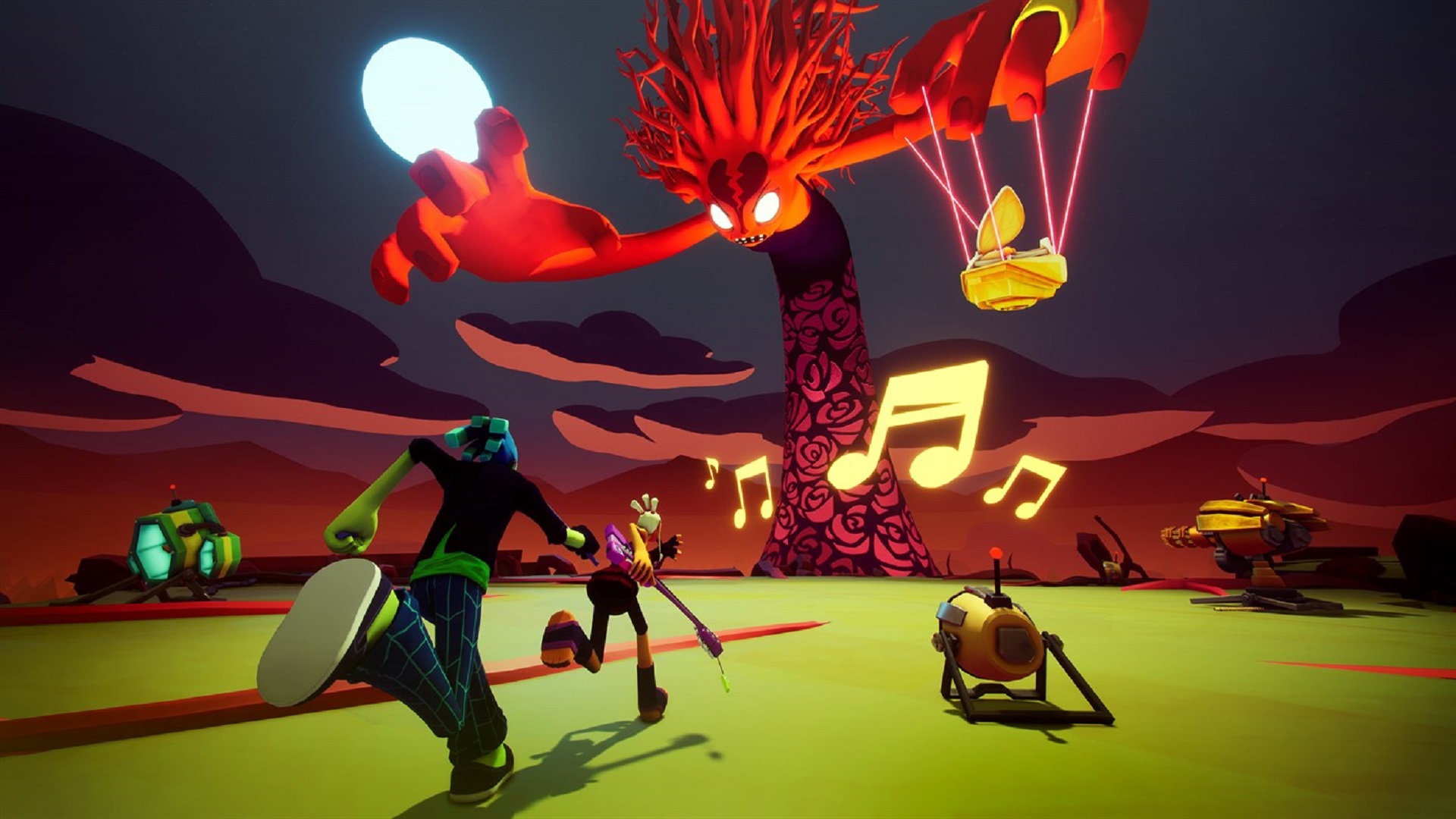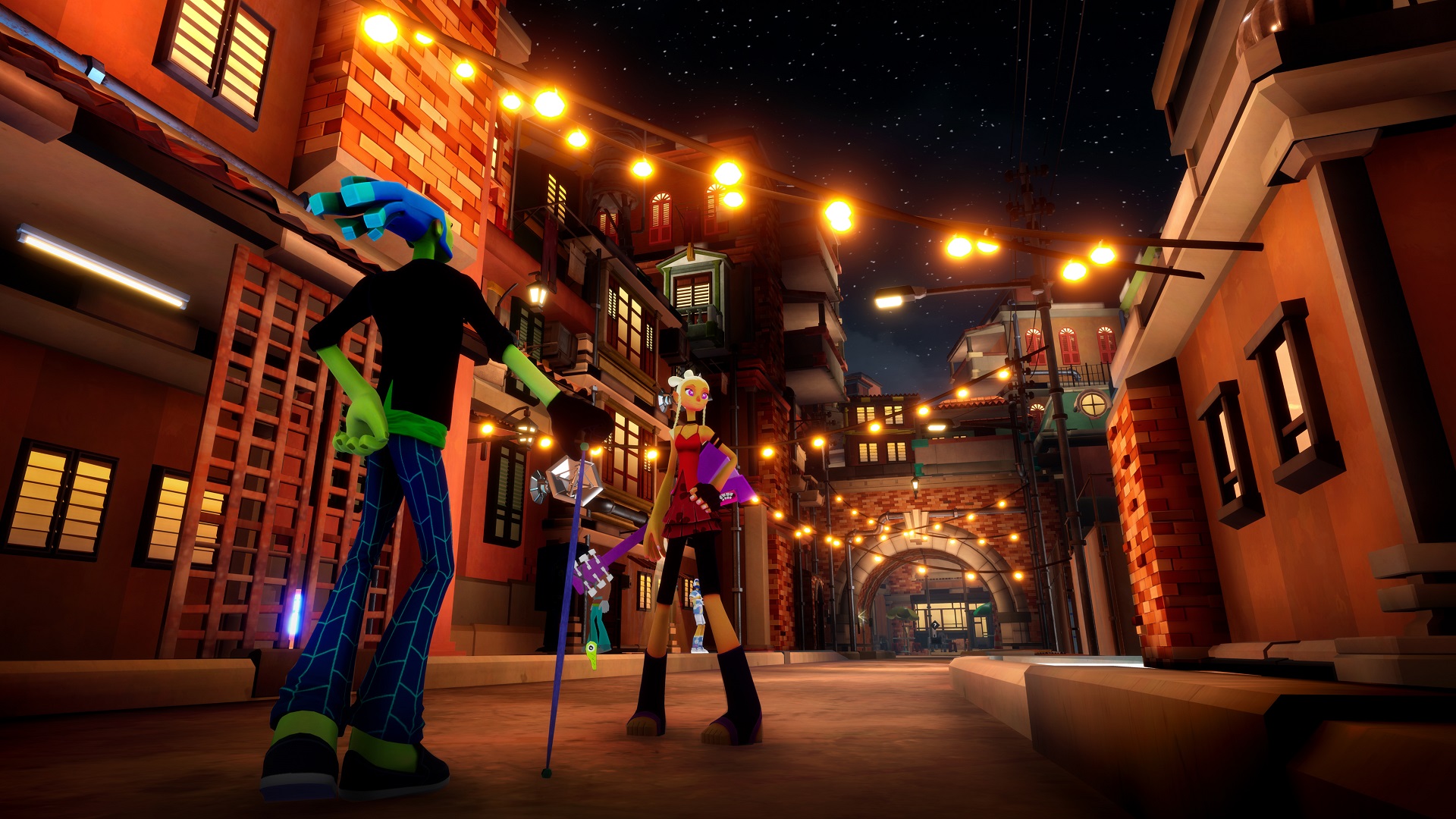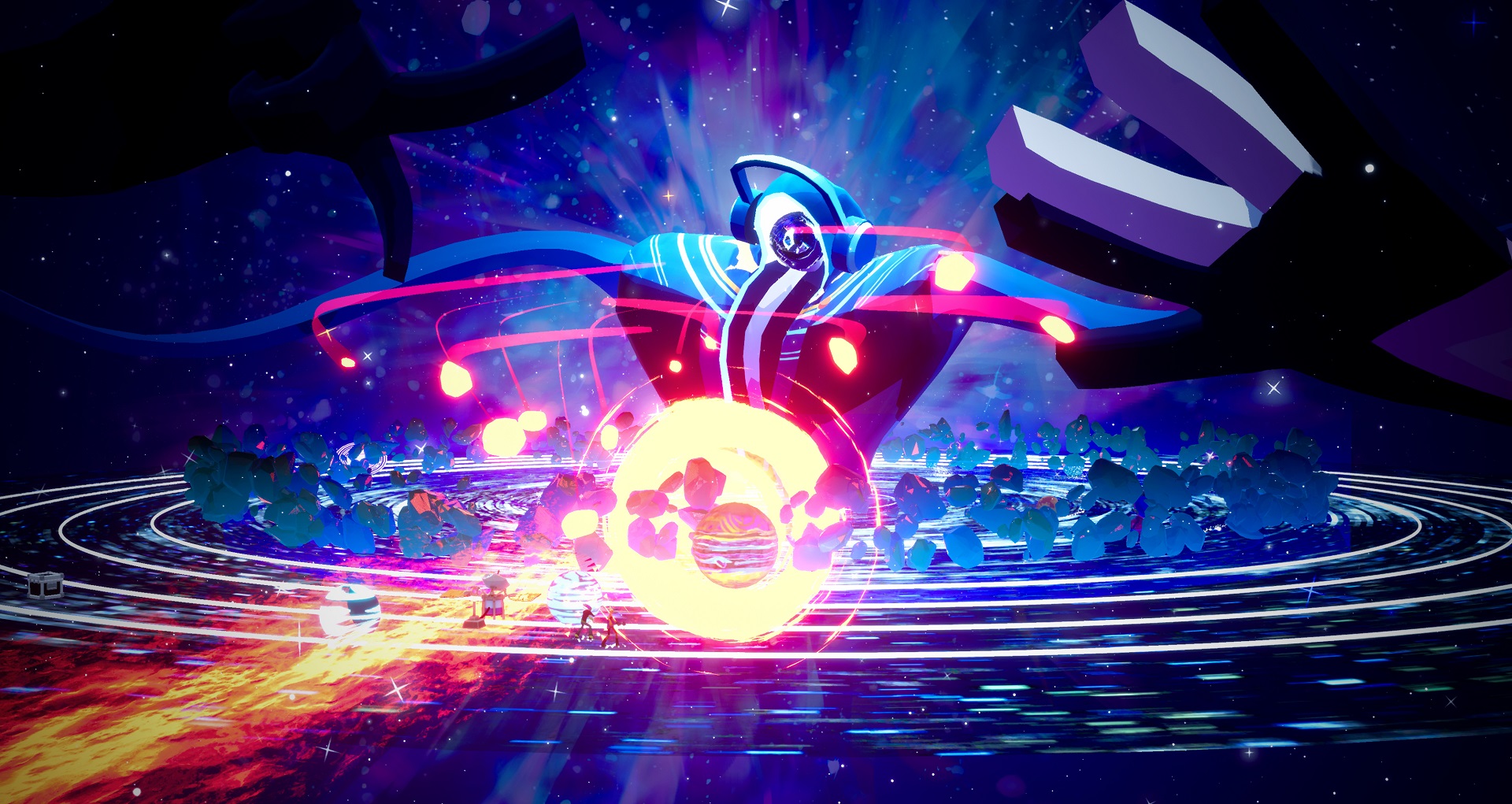
If a game has repetitive, shallow gameplay and core mechanical issues, it doesn’t take long for me to grow a fundamental dislike for it. In that regard, No Straight Roads is a pretty unique case. Metronomik’s debut title is a game that suffers from both those things (and more), and yet I can’t help but smile every time I think about it. This is a game with a lot of heart, one that’s bursting with ambition and creativity- it’s just a shame that it’s held back by a number of significant issues.
In No Straight Roads, you play as Mayday and Zuke, an indie rock duo that’s trying to make it big in Vinyl City. It’s a city that lives and breathes music- it’s governed by a musical organization known as No Straight Roads (or NSR) that uses EDM music to generate electricity that powers the whole city. But it’s also an organization that does it to the exclusion of all other types of music, and that’s something that the rock-loving Mayday and Zuke cannot tolerate. When they witness the corruption and elitism that plagues NSR at the highest levels early on in the game, they decide to start a musical revolution, taking back the city district-by-district by beating various NSR artists – each specializing in a sub-genre of EDM – and bringing power and musical variety back to the people of Vinyl.
"This is a game with a lot of heart, one that’s bursting with ambition and creativity- it’s just a shame that it’s held back by a number of significant issues."
It’s a ridiculous premise, and No Straight Roads knows it. In fact, it goes all in on it. This is a game that wears its heart on its sleeve, and nowhere is that more apparent than how blatantly it puts music front and center constantly, often to the point of being cartoonish. But No Straight Roads embraces that cartoonish nature, and with its combination of a bright and colourful art style, memorable and lovable characters, and a soundtrack that slaps, it does so very successfully.
The starring duo personifies that better than anything else in the game. The energetic and hotheaded guitarist May and the calm and chill drummer Zuke make for an excellent pair. Their personalities are very different, but they fit together like two pieces of a puzzle, and they’re supported by an excellent cast of secondary characters, whether that’s the artists of NSR you’re taking down one-by-one or the people of Vinyl City who’re helping you do that. The interactions that all of these characters have with each other are great as well, providing genuine heart and charming humour in equal measure, which is a testament to the game’s solid writing. Best of all is the voice acting, which bleeds excessive personality into each character that populates that Vinyl City, especially the ones who take center-stage in this story.
The real star of the show in No Straight Roads, however, is obviously the music. With a game that puts music under such a bright spotlight in every way imaginable, it would be fair to say that a good soundtrack is among the most crucial aspects of the experience, and this is an area where No Straight Roads is an unabashed success. From the various styles of EDM music, to the drum and guitar-heavy rock riffs, to even banging rap battles, No Straight Roads has an absolutely excellent soundtrack. It is, fittingly enough, the game’s biggest strength.
The soundtrack really shines in the boss battles, which make up for the bulk of the game. Each boss battle has one predominant style of music associated with it, depending on which EDM artist you’re taking on, but as you progress through each fight and start wearing your foe down, the music dynamically changes, and rock slowly starts bleeding into its electronic tunes, growing louder and more prominent as you get closer and closer to victory. It creates a powerful effect, and serves as an excellent marriage of music and gameplay progression.
"From the various styles of EDM music, to the drum and guitar-heavy rock riffs, to even banging rap battles, No Straight Roads has an absolutely excellent soundtrack. It is, fittingly enough, the game’s biggest strength."
These set-piece boss encounters are bursting with creativity in other ways as well, with each boss fight almost feeling like musical homages to the wacky and psychedelic shenanigans of something like Psychonauts. Each EDM artist you take on is essentially an exaggerated personification of the type of music they specialize in, and their boss fights reflect that, too. When you’re taking on a DJ obsessed with the vast stretches of the universe, you fight against his towering figure as large planetary disco balls orbit around him and asteroids are hurled in your direction. When you take on a digital idol, you find yourself in a virtual world where you have to take down several shields before you can damage her, one each put up by her character designer, voice actor, animator, and video editor. Every boss fight is bonkers and holds nothing back in terms of creativity, and each is a visual and aural delight.
So No Straight Roads clearly has some notable strengths- it looks great, it sounds great, and it tells an engaging story thanks to its excellent cast. But when you look beneath this admittedly dazzling surface, you find a deeply flawed – and ultimately mediocre – game.
No Straight Roads tries to fuse its beat ’em up combat with rhythm game trappings, but it doesn’t do it very well. Enemies attack to the beat of the music, and paying attention to musical cues is how you dodge their attacks. That sounds great on paper, and when it works – when you’re in tune with the soundtrack and are dodging incoming attacks flawlessly – it feels great. The problem is that that isn’t a strict requirement. You can brute force your way through most combat encounters with button mashing, which cheapens the whole premise.
It doesn’t help that the combat itself is very shallow, not only because there isn’t a whole lot you can do other than shooting projectiles, using your basic melee attack, and the couple of special moves you can map to your triggers, but also because there isn’t a ton of enemy variety, and the few enemies that you do run into don’t pose much of a challenge. There is a skill tree that allows you to unlock or upgrade new moves, and you can slap stickers onto your instruments for passive buffs, but both of these systems make a negligible difference, and end up feeling like an afterthought. You can also switch between May and Zuke during combat (when playing solo), but the differences between how the two play and control feel very superficial. Zuke’s attacks are faster, May’s are more powerful- but the game doesn’t ever do much to make that difference feel meaningful.
"No Straight Roads clearly has some notable strengths- it looks great, it sounds great, and it tells an engaging story thanks to its excellent cast. But when you look beneath this admittedly dazzling surface, you find a deeply flawed – and ultimately mediocre – game. "
Other issues rear their heads as well. The camera in particular is quite problematic. While you’re given full control of the camera in the free-roaming sections in Vinyl City, combat encounters all impose fixed camera angles on you. This is a problem because you can’t always judge depth accurately, which leads to both, inaccurate dodging and attacks that don’t find their mark- and it happens frequently enough to become a nuisance. The camera issues are made even worse when you’re forced to engage in light platforming sections – of which there’s quite a few in the game – and these issues are further exacerbated by floaty and unreliable movement.
The result is a combat system that feels all too shallow- and going hand-in-hand with that shallowness is tiring repetition, brought on by No Straight Roads’ structure. The boss encounters I mentioned earlier are easily the best part of the game, but bridging the gap between each of them are light exploration sections in Vinyl City, following by short “approach” sections preceding boss fights that see you fighting grunts and regular enemies. The focus on combat here is the obvious issue- perhaps the game would feel less repetitive if it had better, more satisfying combat. As it exists, it starts wearing thin very quickly.
Exploring Vinyl City is also an inconsistent experience, but it’s still somewhat better. You can interact with a diverse cast of NPCs, collect qwasa tubes that you use to power up dead lights and electronics to restore electricity to the city (which helps you gain more fans, which in turn unlocks more tiers in your skill tree), or look for the aforementioned stickers that grant passive buffs. The city is fairly small, but it looks great. It’s bright and colourful, and each new district that you unlock brings a distinct visual flavour with it- so at least it’s a treat for the eyes.
But much like the rest of the game, though Vinyl City has superficial strengths, exploring it feels mechanically meaningless. You get far too many qwasa tubes, even though powering up electronics doesn’t require too much, which means you’re always left with a surplus. Powering them up doesn’t make too much of a difference either, because you don’t get too many fans by doing this, and defeating bosses remains the best way to net large quantities of fans. Collecting stickers is fun for a while, but once you realize that the buffs they provide are pretty insignificant, you start losing interest.
"Perhaps the game would feel less repetitive if it had better, more satisfying combat. As it exists, it starts wearing thin very quickly."
The sewers that May and Zuke call their home are much more consistently charming though. This home base makes for a great hub location- it’s where you return after every major mission to feed your pets, interact with NPCs, talk with your teammates about your next major step, upgrade your weapons and level up your characters, or just play minigames on the arcade machine. As you progress through the story, you add more rooms to the hub that serve different purposes. Thanks to all of this and more, I found myself looking forward to returning to the sewers quite often.
No Straight Roads is a game of ups and downs, but at the end of the day, one thing is abundantly clear- it’s a game with a lot of superficial strengths, and significant gameplay issues. But calling its strengths “superficial” seems unfair, because they’re so crucial to the kind of experience this is- the music is absolutely killer, the bright and dazzling art style is a sight to behold, and the characters, their writing, and their voice acting are also highlights of the experience. The problem is that your active engagement in this experience comes through mechanics and systems that are either unpolished, or shallow, or repetitive- or worst of all, all three.
This game was reviewed on the PlayStation 4.
Takes a ridiculous narrative premise and does wonders with it; Excellent characters brought to life by sharp writing and solid voice acting; Diverse, bright, and vivid art style; An absolutely killer soundtrack; Bonkers, memorable boss encounters; Charming hub location.
Combat is shallow and doesn't use rhythm elements as much as it should; Camera issues and floaty movement hurt the combat and make for frustrating platforming; Repetitive structure; Exploring Vinyl City is fun on the surface, but mechanically unrewarding.




















